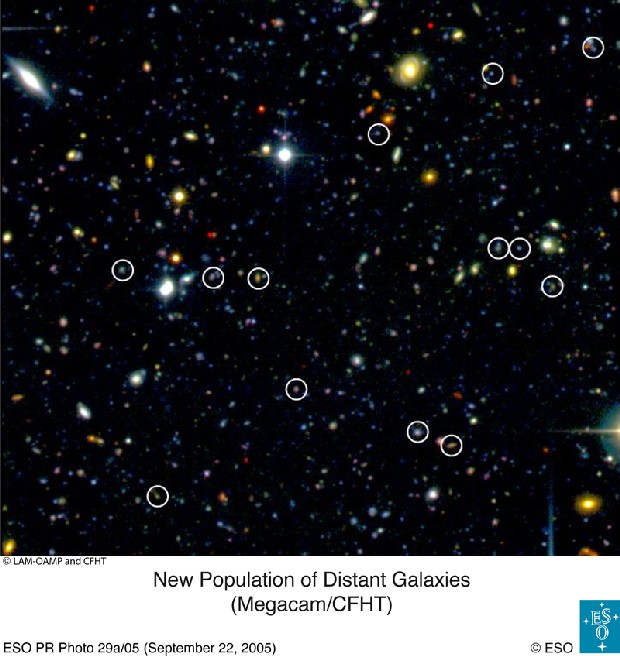
home •
about •
essential guide •
picture of the day •
thunderblogs •
news •
multimedia •
predictions •
products •
get involved •
contact

pic of the day
archive
subject index
abstract
archive
Links:
Society for
Interdisciplinary
Studies
Sep 29, 2005
Too Many Galaxies
An overabundance of galaxies in the early Big Bang universe is just a normal population of next-generation galaxies in the intrinsic-redshift universe.
A press release from the European Southern Observatory (ESO) announces that“a team of French and Italian astronomers ... made use of the VIsible Multi-Object Spectrograph (VIMOS) on Melipal, one of the 8.2-m telescopes of ESO's Very Large Telescope Array. VIMOS can observe the spectra of about 1,000 galaxies in one exposure, from which redshifts, hence distances, can be measured....
“[Their] aim is to measure in some selected patch of the sky the redshift of all galaxies brighter than magnitude 24 in the red....
“In a total sample of about 8,000 galaxies selected only on the basis of their observed brightness in red light, almost 1,000 bright and vigorously star forming galaxies were discovered at an epoch 1,500 to 4,500 million years after the Big Bang (redshift between 1.4 and 5)....
“While observations and models have consistently indicated that the Universe had not yet formed many stars in the first billion years of cosmic time, the discovery made by the scientists calls for a significant change in this picture.”
But for the past several decades, astronomer Halton Arp and a handful of coworkers have been finding that high-redshift galaxies and quasars are associated with, often connected to, nearby active galaxies. To see these associations, Arp and his colleagues had to look at a wider field of view. Blind faith in the redshift-equals-distance dogma prevents conventional astronomers from looking outside their narrow fields of view to see what large, bright active galaxies are nearby. Arp’s observations undermine the conventional redshift-equals-distance assumption. Small, faint, high-redshift galaxies are not far away but are actually small, faint, and nearby.
With Arp’s observations in mind, it’s no surprise that there are many more galaxies with high redshifts than can be accounted for in the Big Bang model: The Big Bang requires many billions of years for galaxies to form after the initial explosion. But in Arp’s universe, active galaxies are continually “giving birth” to quasars, which “grow up” into small, faint galaxies and then into companion galaxies.
A proper scientific study would supplement the survey of “galaxies selected only on the basis of their observed brightness” with another that analyzes the selected galaxies’ distance from and alignment with active galaxies in the vicinity.
EXECUTIVE EDITORS:
David Talbott, Wallace Thornhill
MANAGING EDITOR:
Mel Acheson
CONTRIBUTING EDITORS: Michael Armstrong, Dwardu Cardona, Ev Cochrane,
C.J. Ransom, Don Scott, Rens van der Sluijs, Ian Tresman
WEBMASTER: Michael Armstrong
Copyright 2005: thunderbolts.info